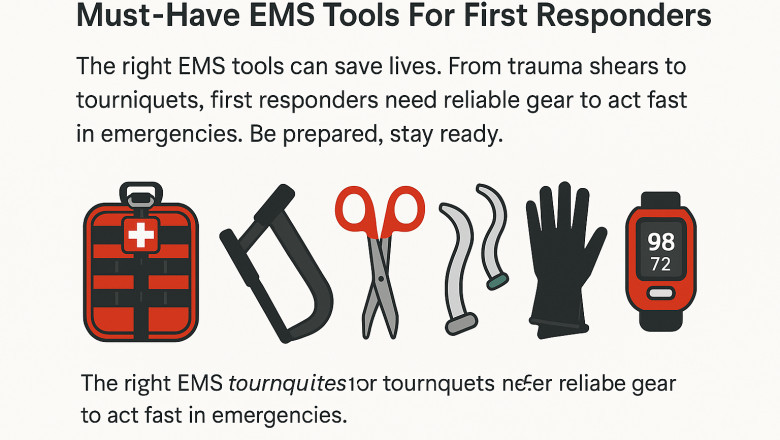views
When lives are on the line, there is no time for hesitating or second-guessing your decisions. First responders do not have time to dig through a disorganised bag or struggle with unreliable gear. Today, the demands of emergency medical services (EMS) are more intense than ever. All EMTs, paramedics, and firefighters need to be faster, sharper, and better equipped than ever.
This is why the right EMS tools and accessories can make a difference between life and death. So, let’s discuss what the must-haves are that every first responder should carry.
The Evolution of EMS Tools: From Basic Kits to Advanced Gear
EMS tools have come a long way from the simple first-aid kits that were used in the past. Decades ago, first responders used to rely on:
- Basic Bandages for wound care.
- Rudimentary Splints to stabilise fractures.
- Manual resuscitators for breathing support.
These days, however, the technology has advanced to a cutting-edge level with:
- Automated CPR devices for consistent chest compressions.
- Portable defibrillators to improve survival rates in cardiac arrests.
- High-tech diagnostic equipment for quick and accurate assessments.
As the medical challenges and emergency scenarios increase with the population, modern EMS professionals need gear that is not only effective but also easy to deploy.
Must-Have EMS Tools For First Responders
Medical Pouches
If your gear is not organized, it’s useless. Medical pouches are more than just bags, they are the command centers of your kit. The best ones are usually the ones with MOLLE (Modular Lightweight Load-Carrying Equipment) compatibility. This means that you can easily attach them to belts, vests, or backpacks. It is best to look for pouches with multiple compartments and durable zippers that won’t fail under pressure. A solid medical pouch will have enough space to hold your bandages, trauma shears, and other must-haves right where you need them—fast.
Tourniquets
Uncontrolled bleeding is one of the fastest ways to lose a life in an emergency. This is why a tourniquet should always be within arm’s reach. And no, not those cheap knockoffs—get the real deal. Though the first responders are trained for these situations, it is always nice to have a one-handed tourniquet in your medical pouch.
Trauma Shears
Trauma shears are another must-have that are designed to slice through clothing, seatbelts, and even leather boots in seconds. The best models feature a titanium-coated blade with a good grip, making them reliable for any emergency. If you are struggling to get to a wound, it is time to pull out a good pair of trauma shears to eliminate that problem.
Nasal Airways (NPAs) and Oral Airways (OPAs)
If a patient can not breathe, nothing else matters. Nasopharyngeal airways and oropharyngeal airways should be in every first responder’s medical pouch. They prevent airway obstructions and keep oxygen flowing until advanced care arrives or till you can reach the hospital.
Gloves
Blood, vomit, chemicals—you name it, first responders deal with it. If, as a first responder, you are not wearing proper gloves, you are putting yourself at risk. Nitrile gloves offer the best protection, resist punctures, and other bodily fluids. Make sure to carry multiple pairs with you in your medical pouch because you’ll never know when you need them.
Blood-Clotting Agents
Sometimes direct pressure is not enough. You need medical-grade clotting agents to control severe bleeding within seconds and accelerate the clotting process. Remember to always carry them because you’ll never know when you need them.
Pulse Oximeter
During the time of an emergency, it is important to check your patient’s oxygen saturation. A compact pulse oximeter clips onto the fingertip and provides real-time readings of oxygen levels and heart rate. Hypoxia is a very common problem during medical emergencies, but with a pulse oximeter, you can stay one step ahead.
Stethoscope
The use of a stethoscope is not just limited to hospitals. A high-quality stethoscope allows you to asses lung sounds, heartbeats and even detect pneumothorax in the field. A cheap stethoscope won’t pick up crucial details, so invest in a good one.
Flashlight
Emergencies don’t always happen in the light of day. A high-lumen flashlight with a sturdy grip and rechargeable battery is non-negotiable. Headlamps are also great when you need to work hands-free in tight or dark places.
CPR Mask
Mouth-to-mouth resuscitation is crucial, but direct contact can pose health risks. A compact CPR mask with a one-way valve protects both you and the patient while delivering lifesaving breaths.
Final Thoughts
In a crisis, every second matters, and having the right EMS tools and accessories can make all the difference. If you are serious about your job, you need to be equipped with the best. Your medical pouches should be stocked, your gear should be top-quality, and your training should match your tools. So, get the best and carry the best!














Comments
0 comment